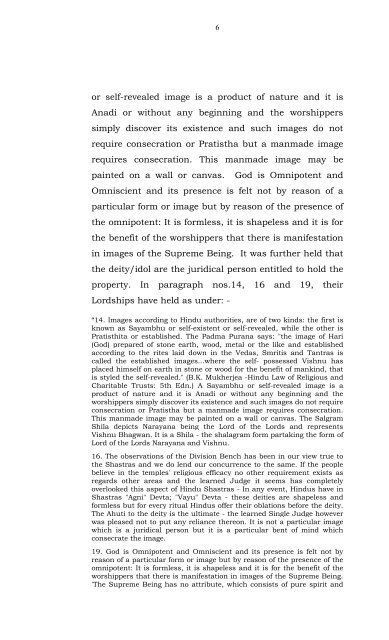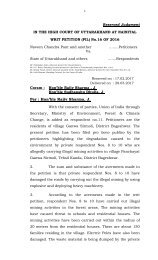Create successful ePaper yourself
Turn your PDF publications into a flip-book with our unique Google optimized e-Paper software.
6<br />
or self-revealed image is a product <strong>of</strong> nature and it is<br />
Anadi or without any beginning and the worshippers<br />
simply discover its existence and such images do not<br />
require consecration or Pratistha but a manmade image<br />
requires consecration. This manmade image may be<br />
painted on a wall or canvas. God is Omnipotent and<br />
Omniscient and its presence is felt not by reason <strong>of</strong> a<br />
particular form or image but by reason <strong>of</strong> the presence <strong>of</strong><br />
the omnipotent: It is formless, it is shapeless and it is for<br />
the benefit <strong>of</strong> the worshippers that there is manifestation<br />
in images <strong>of</strong> the Supreme Being. It was further held that<br />
the deity/idol are the juridical person entitled to hold the<br />
property. In paragraph nos.14, 16 and 19, their<br />
Lordships have held as under: -<br />
“14. Images according to Hindu authorities, are <strong>of</strong> two kinds: the first is<br />
known as Sayambhu or self-existent or self-revealed, while the other is<br />
Pratisthita or established. The Padma Purana says: "the image <strong>of</strong> Hari<br />
(God) prepared <strong>of</strong> stone earth, wood, metal or the like and established<br />
according to the rites laid down in the Vedas, Smritis and Tantras is<br />
called the established images...where the self- possessed Vishnu has<br />
placed himself on earth in stone or wood for the benefit <strong>of</strong> mankind, that<br />
is styled the self-revealed." (B.K. Mukherjea -Hindu Law <strong>of</strong> Religious and<br />
Charitable Trusts: 5th Edn.) A Sayambhu or self-revealed image is a<br />
product <strong>of</strong> nature and it is Anadi or without any beginning and the<br />
worshippers simply discover its existence and such images do not require<br />
consecration or Pratistha but a manmade image requires consecration.<br />
This manmade image may be painted on a wall or canvas. The Salgram<br />
Shila depicts Narayana being the Lord <strong>of</strong> the Lords and represents<br />
Vishnu Bhagwan. It is a Shila - the shalagram form partaking the form <strong>of</strong><br />
Lord <strong>of</strong> the Lords Narayana and Vishnu.<br />
16. The observations <strong>of</strong> the Division Bench has been in our view true to<br />
the Shastras and we do lend our concurrence to the same. If the people<br />
believe in the temples' religious efficacy no other requirement exists as<br />
regards other areas and the learned Judge it seems has completely<br />
overlooked this aspect <strong>of</strong> Hindu Shastras - In any event, Hindus have in<br />
Shastras "Agni" Devta; "Vayu" Devta - these deities are shapeless and<br />
formless but for every ritual Hindus <strong>of</strong>fer their oblations before the deity.<br />
The Ahuti to the deity is the ultimate - the learned Single Judge however<br />
was pleased not to put any reliance thereon. It is not a particular image<br />
which is a juridical person but it is a particular bent <strong>of</strong> mind which<br />
consecrate the image.<br />
19. God is Omnipotent and Omniscient and its presence is felt not by<br />
reason <strong>of</strong> a particular form or image but by reason <strong>of</strong> the presence <strong>of</strong> the<br />
omnipotent: It is formless, it is shapeless and it is for the benefit <strong>of</strong> the<br />
worshippers that there is manifestation in images <strong>of</strong> the Supreme Being.<br />
'The Supreme Being has no attribute, which consists <strong>of</strong> pure spirit and



